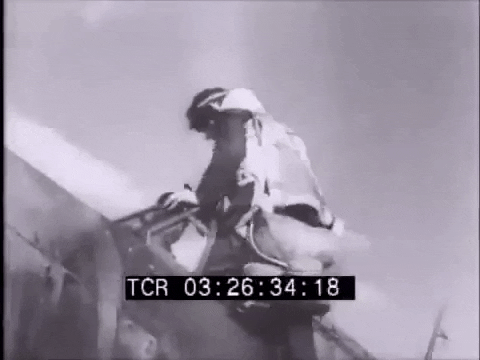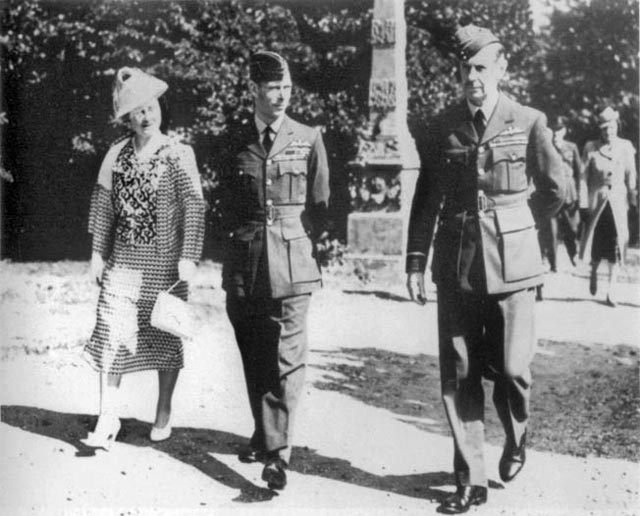A Grave Injustice Done to a War Hero
 |
| Air Chief Marshal Sir Hugh Dowding and Douglas Bader at the conclusion of World War II. If the meeting appears a bit awkward, there is a good reason for that which we will get to below. |
Dowding spent over a decade before World War II in Royal Air Force leadership positions building up the institution and infrastructure. While not considered the "father" of the force (that was Marshal of the Royal Air Force Hugh Montague Trenchard), Dowding played a large role in building the modern RAF that wound up facing off against the Luftwaffe.
 |
| Dowding presides over the graduation exercises at RAF College, Cranwell, in 1930. He became the director of training at the Air Ministry in 1926 and advanced rapidly after that. |
Air Marshal Hugh Dowding Guided the RAF Through Dangerous Times
Dowding, intending to retire in June 1939, showed excellent judgment after being asked to remain in office due to the war crisis. He displayed an outstanding grasp of the air war and the proper uses of the RAF interceptor force. There was nothing outdated about his thinking and he clearly understood the power and limitations of modern fighters. He developed the “Dowding System” for early warning of air attacks that incorporated radar chains on the south coast, radio control of aircrews, the Duxford Operations Room, and the underground Operations Room at Headquarters Fighter Command, Bentley Priory, Middlesex. The cutting-edge Dowding System proved vital during the war. Hugh Dowding was no Dudley Pound falling asleep at strategy meetings. |
| Dowding established the entire RAF command and control operation, including RAF Fighter Command headquarters at Bentley Priory. |
 |
| In his role as the commanding officer of the newly created RAF Fighter Command beginning in 1936, Dowding oversaw the introduction of the Hawker Hurricane, above, and other modern fighters. |
On 11 June 1940, with France crumbling, Dowding reiterated his position against sending fighters to France (they demanded “the entire RAF”). Churchill agreed with him. This was an extremely tough decision because it furthered the breach between France and the UK. However, Dowding was looking after his country’s survival.
On 23 July 1940, Dowding succeeded in getting convoys routed away from the east coast and sent north around Scotland instead. He knew the RAF was so weak it could not protect the ships even right along the coastline. On 28 July 1940, he moved his fighters closer to the Channel to better confront the Luftwaffe, a very aggressive move that led to the famous Luftwaffe losses in August.
 |
| While RAF planes were in short supply early in the conflict, pilots became scarce as time went on. Dowding took decisive steps to maintain enough of both. |
So far, so good. Dowding skillfully preserved his fighter force and kept it at full strength through a sequence of canny moves. In September 1940, after the peak of the Battle of Britain, his problems began. That is when Air Marshal Hugh Dowding finally met enemies he could not overcome.
Dowding Falls Victim to Careerists in the RAF
Air Vice-Marshal Trafford Leigh-Mallory of No. 12 Group (north of London), who was a bit of a schemer, had developed what became known as the “Big Wing” concept. In simple terms, the Big Wing involved assembling a large force of fighters (three or four squadrons) over RAF bases before sending them as a group to attack incoming Luftwaffe bomber streams. This had some advantages - it meant maximum-strength interceptions. However, its major failing was that it took time to assemble these large forces. By the time the RAF set out to intercept the bombers, the Germans had completed their work of bombing cities and turned back to France. The Big Wing tactic, however, worked well for forces further back from the “front” that had time to assemble before their own bases came under attack.Dowding did not like the Big Wing concept. He preferred sending smaller groups of fighters immediately as they got airborne to intercept the bombers. This disrupted enemy bombing operations and gave more opportunities for shoot-downs. Dowding’s strategy was arguably better for front-line units that were under immediate threat and did not have time for leisurely assemblies. Each strategy obviously had strengths and weaknesses and reasonable people could disagree. This may seem like a minor policy disagreement that could have been settled over after-dinner cognacs, but it led to Dowding’s downfall.
 |
| Keith Park in his personalized Hurricane, which he flew to the ten airfields under his command in No. 11 Group. His personal insignia, Cerberus, is to the extreme left. |
So, two power blocks emerged within the RAF: the warriors Dowding and Park, opposed by the Air Ministry and Leigh-Mallory (who was in command of a secondary zone but coveted Park’s prestigious job). They could not coexist, one power block or the other was going to win and the other lose. This internal struggle ultimately became more about power than strategy.
 |
| From right to left, Air Chief Marshal Hugh Dowding, King George VI, and Elizabeth Bowes-Lyon during the Battle of Britain. |
 |
| Douglas Bader swinging his artificial leg into his fighter before a 1945 flight. |
As always seems to happen in bureaucratic infighting, the battle was decided at a staff meeting. At a key high-level RAF meeting held on 17 October 1940, with the Battle of Britain basically won, Leigh-Mallory brought Bader (who had no reason to be there) to argue for the BIg Wing concept and against Dowding and Park. The political clout of Bader, combined with the institutional power of Leigh-Mallory and the Air Ministry itself, was too much for Dowding (who could be shunted aside as “too old”) and Park (who wasn’t even English, for goodness sakes). This meeting led directly to the sacking of both Dowding and Park - the two men most responsible for the winning of the Battle of Britain.
Where They All Wound Up
Dowding then “retired” (he actually just went to a staff position in the United States, the standard dumping ground for the losers such as Lord Halifax in British bureaucratic struggles). Park was transferred to a humiliating training position (he later rebounded with prestigious commands including Malta and is considered quite a war hero in New Zealand).Bader got his rewards, too. He quickly received the Distinguished Flying Cross (DFC) on 12 December 1940 and was promoted to acting wing commander and became one of the first "wing leaders" on 18 March 1941. In 1941, Bader again combined with Leigh-Mallory in an abortive attempt to equip Spitfires with four .303 machine guns, which Bader personally preferred, instead of .50 machine guns. The larger guns proved more effective and Bader's plans came to naught. He was shot down in combat on 9 August 1941 and spent the remaining war years as a guest of the German government, primarily in Colditz Castle Oflag IV-C.
 |
| Douglas Bader's home for much of World War II was Colditz Castle POW camp. |
Douglas was all for the Big Wings to counter the German formation[s]. I think there was room for both tactics – the Big Wings and the small squadrons. It might well have been fatal had Park always tried to get his squadrons into "Balbos," for not only would they have taken longer to get to their height, but sixty or seventy packed climbing fighters could have been seen for miles and would have been sitting ducks for higher 109s.So, there were pluses and minuses to the "Big Wing," more appropriate for units further from the front than front-line units as Dowding and Park knew. It certainly was not worth a major leadership shakeup in the RAF. In any event, the days of large Luftwaffe daylight raids were over. The "Wing" name lived on as an organizational title meaning a group of squadrons, but the "Big Wing" concept died a quick death.
Conclusion
There was no reason to remove Dowding (or Park). They had both done outstanding work and continued to do outstanding work. The “Big Wing” concept had major failings and was just a handy way to get rid of them. Dowding and Park were the victims of a political purge in which the victors took the spoils. After they had done the “heavy lifting” that won the Battle of Britain and having shouldered the risk of massive failure, Dowding and Park were efficiently disposed of by the real powers within the RAF.In a way, Dowding was a victim of his own success. Having won the Battle of Britain through brilliant leadership, he created a nation-saving victory that others coveted - and basically took from him.
 |
| Sir Hugh Dowding (left) at a 1949 commemoration of World War II. |
2020




The picture with »Edward VI« in the middle actually shows George VI (Edward VI died in 1537). His wife (on his right hand side) Lady Elizabeth Bowes-Lyon wasn't »queen«. Their daughter Elizabeth is queen nowadays, but her husband Prince Philip isn't king... ;-)
ReplyDelete